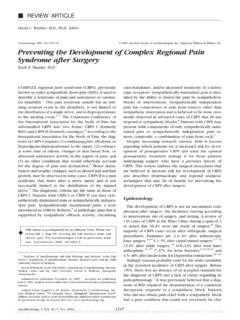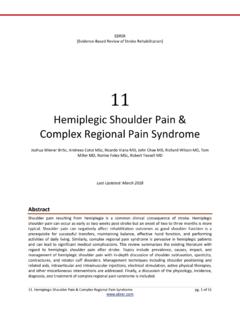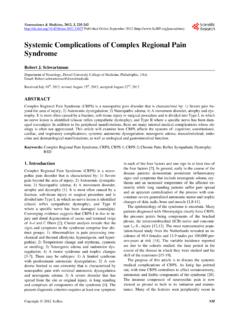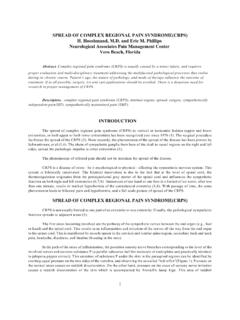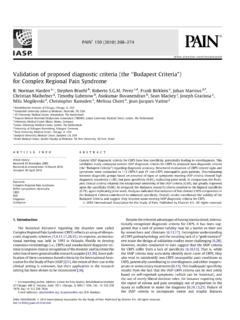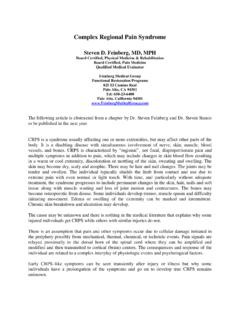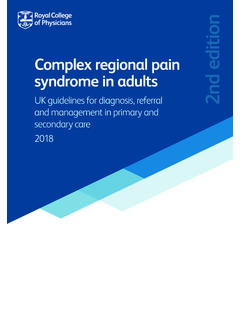Transcription of Diseases and Conditions Complex regional pain syndrome
1 Complex regional pain syndrome - Mayo [6/18/2015 10:04:51 AM] Diseases and ConditionsComplex regional pain syndromeComplex regional pain syndrome is an uncommon form of chronic pain that usually affects an arm or aleg. Complex regional pain syndrome typically develops after an injury, surgery, stroke or heart attack,but the pain is out of proportion to the severity of the initial cause of Complex regional pain syndrome isn't clearly understood. Treatment for Complex regionalpain syndrome is most effective when started early.
2 In such cases, improvement and even remission and symptoms of Complex regional pain syndrome include:Continuous burning or throbbing pain , usually in your arm, leg, hand or footSensitivity to touch or coldSwelling of the painful areaChanges in skin temperature at times your skin may be sweaty; at other times it may be coldChanges in skin color, which can range from white and mottled to red or blueChanges in skin texture, which may become tender, thin or shiny in the affected areaChanges in hair and nail growthJoint stiffness, swelling and damageMuscle spasms, weakness and loss (atrophy)Decreased ability to move the affected body partSymptoms may change over time and vary from person to person.
3 Most commonly, pain , swelling,redness, noticeable changes in temperature and hypersensitivity (particularly to cold and touch) time, the affected limb can become cold and pale and undergo skin and nail changes as well asmuscle spasms and tightening. Once these changes occur, the condition is often regional pain syndrome occasionally may spread from its source to elsewhere in your body,such as the opposite limb. The pain may be worsened by emotional Mayo Clinic StaffLast Viewed by First Circuit Library on 06/18/2015 Complex regional pain syndrome - Mayo [6/18/2015 10:04:51 AM]In some people, signs and symptoms of Complex regional pain syndrome go away on their own.
4 In others,signs and symptoms may persist for months to years. Treatment is likely to be most effective whenstarted early in the course of the to see a doctorIf you experience constant, severe pain that affects a limb and makes touching or moving that limb seemintolerable, see your doctor to determine the cause. It's important to treat Complex regional painsyndrome regional pain syndrome occurs in two types, with similar signs and symptoms, but differentcauses:Type 1. Also known as reflex sympathetic dystrophy syndrome , this type occurs after an illness orinjury that didn't directly damage the nerves in your affected limb.
5 About 90 percent of people withcomplex regional pain syndrome have type 2. Once referred to as causalgia, this type follows a distinct nerve cases of Complex regional pain syndrome occur after a forceful trauma to an arm or a leg, such asa crush injury, fracture or amputation. Other major and minor traumas such as surgery, heart attacks,infections and even sprained ankles also can lead to Complex regional pain syndrome . Emotionalstress may be a precipitating factor, as 's not well-understood why these injuries can trigger Complex regional pain syndrome , but it may be dueto a dysfunctional interaction between your central and peripheral nervous systems and inappropriateinflammatory Complex regional pain syndrome isn't diagnosed and treated early, the disease may progress to moredisabling signs and symptoms.
6 These may include:Tissue wasting (atrophy). If you avoid moving an arm or a leg because of pain or if you havetrouble moving a limb because of stiffness, your skin, bones and muscles may begin to deteriorateand tightening (contracture). You also may experience tightening of your muscles. Thismay lead to a condition in which your hand and fingers or your foot and toes contract into a get the best medical care, take time to prepare for your you can doWrite down any symptoms you're experiencing including the severity and location of your pain ,stiffness or sensitivity.
7 It's also a good idea to write down any questions you have for your of questions you might ask your doctor include:What's the likely cause of the symptoms I m experiencing?What kinds of tests, if any, do I need?Last Viewed by First Circuit Library on 06/18/2015 Complex regional pain syndrome - Mayo [6/18/2015 10:04:51 AM]Is my condition likely temporary or chronic?What types of treatments are available? Which do you recommend?What are the alternatives to the primary approach that you're suggesting?I have these other health Conditions .
8 How can I best manage them together?Is there a generic alternative to the medicine you're prescribing for me?Are there any brochures or other printed material that I can take home? What websites do yourecommend?In addition to the questions that you've prepared to ask your doctor, don't hesitate to ask additionalquestions during your to expect from your doctorYour doctor is likely to ask you a number of questions. Being ready to answer them may reserve time togo over any points you want to spend more time on. For Complex regional pain syndrome , your doctormay ask:Have you had a recent accident, illness or injury, such as trauma to your limbs, a heart attack or aninfection?
9 Have you had surgery recently?When did you first begin experiencing pain or burning?How long have you been experiencing your symptoms?Is the pain occasional or continuous?Does anything seem to improve or worsen your symptoms?Have you experienced similar symptoms after past injuries?Diagnosis of Complex regional pain syndrome is based on a physical exam and your medical 's no single test that can definitively diagnose Complex regional pain syndrome , but the followingprocedures may provide important clues:Bone scan. This procedure may help detect bone changes.
10 A radioactive substance injected intoone of your veins permits viewing of your bones with a special nervous system tests. These tests look for disturbances in your sympatheticnervous system. For example, thermography measures the skin temperature and blood flow of youraffected and unaffected tests can measure the amount of sweat on both limbs. Dissimilar results can indicate complexregional pain Loss of minerals from your bones may show up on an X-ray in later stages of the resonance imaging (MRI). Images captured by an MRI device may show a numberof tissue and even remission of Complex regional pain syndrome is possible if treatment beginsLast Viewed by First Circuit Library on 06/18/2015 Complex regional pain syndrome - Mayo [6/18/2015 10:04:51 AM]within a few months of your first symptoms.



